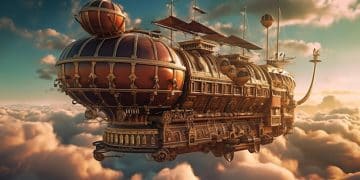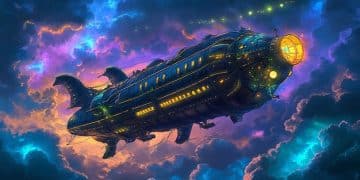Science Fiction’s 2050: How Accurate are Sci-Fi Novel Predictions?
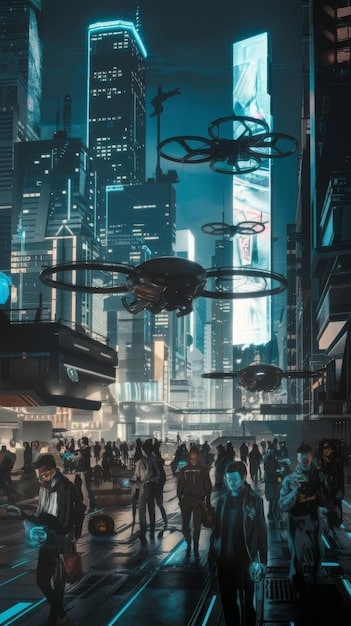
Science Fiction’s Predictions: How Accurate are Science Fiction Novels About 2050? explore themes like technological advancements, environmental crises, and societal shifts, often envisioning futures that both inspire and caution, raising questions about human adaptability and our planet’s trajectory.
Have you ever wondered if the future depicted in your favorite science fiction novels could actually come true? What if those futuristic cities, advanced technologies, and societal structures weren’t just figments of imagination? Let’s delve into Science Fiction’s Predictions: How Accurate are Science Fiction Novels About 2050?, separating fact from fiction.
The Allure of Predicting the Future in Science Fiction
Science fiction has always captivated audiences with its imaginative visions of tomorrow. Beyond mere entertainment, these narratives often serve as thought experiments, exploring potential consequences of current trends and technological advancements. By projecting ourselves into these imagined futures, we gain a unique perspective on our present and can begin to consider the possibilities—both utopian and dystopian—that lie ahead.
But how accurate are these fictional forecasts? Are science fiction writers merely creating fantastical worlds, or are they offering prescient glimpses into what our future might hold? The year 2050, often used as a benchmark in science fiction, is close enough to feel tangible, yet far enough away to allow for significant technological and societal shifts.
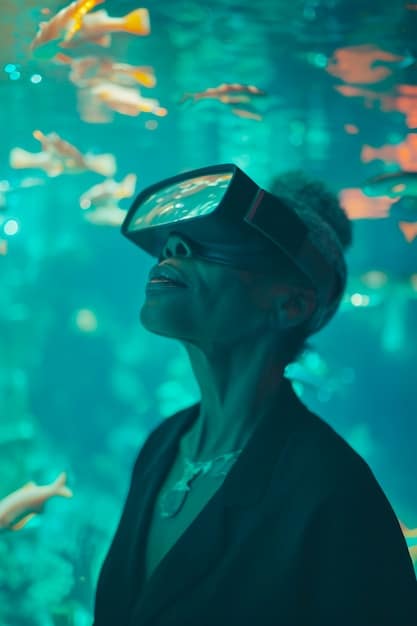
The Power of Extrapolation
One reason science fiction sometimes gets it right is its reliance on extrapolation. Authors analyze current trends—scientific, technological, social, and political—and project them forward, often amplifying their potential impact. This process allows them to imagine the downstream effects of these trends, leading to surprisingly accurate predictions.
- Climate Change: Many sci-fi novels written decades ago foresaw the devastating effects of climate change, including rising sea levels, extreme weather events, and resource scarcity.
- Technological Integration: The pervasive integration of technology into our daily lives, from smartphones to artificial intelligence, was a common theme long before these technologies became ubiquitous.
- Social and Political Shifts: Science fiction has also explored potential shifts in social and political structures, such as the rise of global corporations, increasing social inequality, and the erosion of privacy.
Science fiction’s power lies in its ability to combine creative storytelling with insightful analysis, offering compelling and thought-provoking visions of the future. It challenges us to consider the potential consequences of our actions and choices, inspiring us to shape a better tomorrow.
Technological Advancements: From Fiction to Reality
One of the most intriguing aspects of science fiction is its predictive power regarding technological advancements. Many technologies once confined to the pages of novels have now become a reality, shaping our lives in profound ways.
Let’s examine some key technological predictions made in science fiction and explore how closely they align with our current reality. From artificial intelligence to virtual reality, the line between fiction and reality continues to blur.
Artificial Intelligence and Robotics
The concept of artificial intelligence has been a staple of science fiction for decades, with novels like “Do Androids Dream of Electric Sheep?” by Philip K. Dick exploring the ethical and societal implications of advanced AI. While we haven’t yet achieved the level of sophisticated AI depicted in these stories, significant strides have been made in recent years.
- AI Assistants: Virtual assistants like Siri, Alexa, and Google Assistant are now commonplace, demonstrating the increasing integration of AI into our daily lives.
- Robotics: Robots are being used in manufacturing, healthcare, and even exploration, performing tasks that are too dangerous or difficult for humans.
- Machine Learning: Machine learning algorithms are powering everything from personalized recommendations to fraud detection, demonstrating the growing capabilities of AI systems.
While fully sentient AI remains a distant prospect, the advancements in AI and robotics are undeniable, mirroring many of the predictions made in science fiction. These technologies are poised to transform our world in profound ways, raising important ethical and societal questions.
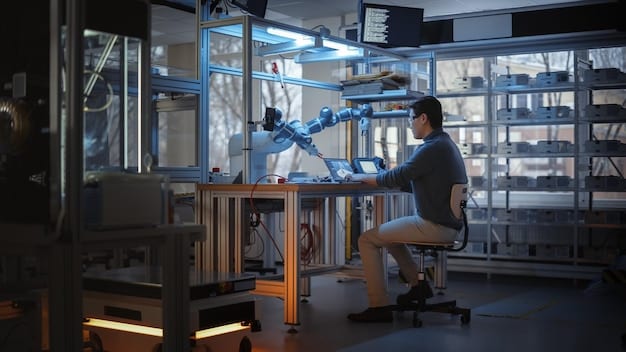
Environmental Concerns: A Recurring Theme
Beyond technological advancements, science fiction has also served as a powerful platform for exploring environmental concerns. Many novels have depicted dystopian futures ravaged by climate change, pollution, and resource depletion.
These cautionary tales often reflect real-world concerns about the state of our planet and the potential consequences of our actions. By highlighting the potential for environmental disaster, science fiction can raise awareness and inspire action.
Dystopian Visions of Environmental Collapse
Novels like “The Water Knife” by Paolo Bacigalupi and “Oryx and Crake” by Margaret Atwood paint bleak pictures of futures where water scarcity, extreme weather events, and ecological devastation have become the norm. These scenarios, while fictional, are rooted in scientific realities and serve as stark warnings about the potential consequences of environmental neglect.
These environmental concerns are not new, but science fiction has played a crucial role in bringing them to the forefront of public consciousness. By imagining the worst-case scenarios, these novels inspire us to take action and work towards a more sustainable future.
Social and Political Structures: Echoes of Today
Science fiction often explores potential shifts in social and political structures, imagining futures where traditional hierarchies are upended, new forms of governance emerge, and societal norms are redefined.
These narratives can offer valuable insights into our present social and political landscape, highlighting potential challenges and opportunities that lie ahead. By examining these fictional worlds, we can gain a better understanding of the forces shaping our own society.
Exploring Alternative Social and Political Systems
Novels like “The Dispossessed” by Ursula K. Le Guin and “Snow Crash” by Neal Stephenson explore alternative social and political systems, ranging from anarchist utopias to corporatocratic dystopias. These narratives challenge us to question our own assumptions about governance, power, and social organization.
- Globalization: The increasing interconnectedness of the world, driven by technology and trade, is reshaping national identities and creating new forms of global governance.
- Social Inequality: The widening gap between the rich and poor is a growing concern, with potential implications for social stability and political polarization.
- Technological Surveillance: The increasing use of surveillance technologies raises questions about privacy, freedom, and the potential for authoritarian control.
Science fiction provides a safe space to explore these complex issues, allowing us to imagine different possibilities and consider their potential consequences. By engaging with these narratives, we can become more informed and engaged citizens, better equipped to shape the future of our society.
Science Fiction as a Mirror to Society
Science fiction’s enduring appeal lies in its ability to reflect our own society back at us, often in distorted or exaggerated forms. By exploring potential futures, these narratives can shed light on our present values, anxieties, and aspirations.
This mirror effect can be both unsettling and illuminating, prompting us to examine our own beliefs and behaviors. Science fiction serves as a powerful tool for self-reflection, helping us to understand ourselves and our place in the world.
Examining Contemporary Issues Through a Futuristic Lens
Many science fiction novels tackle contemporary issues, such as climate change, social inequality, and technological disruption, by projecting them into the future. This allows authors to explore the potential long-term consequences of these issues and to offer new perspectives on their underlying causes.
Science fiction’s ability to serve as a mirror to society makes it a valuable tool for understanding ourselves and the world around us. It challenges us to think critically, question assumptions, and imagine new possibilities.
The Limits of Prediction: Imagination vs. Reality
While science fiction often gets it right, it’s important to acknowledge the limits of prediction. The future is inherently uncertain, and many factors can influence the course of events. Science fiction writers are, after all, limited by their own imaginations and perspectives.
Moreover, science fiction is not always intended to be a literal prediction of the future. Often, these narratives are more concerned with exploring themes, ideas, and human nature than with forecasting specific events.
Acknowledging the Role of Imagination and Speculation
Science fiction relies heavily on imagination and speculation, often pushing the boundaries of what is scientifically possible. While some of these ideas may eventually become reality, others may remain firmly in the realm of fiction.
- Unforeseen Innovations: The future is likely to hold innovations that we cannot even imagine today. Breakthroughs in science and technology can disrupt existing trends and create entirely new possibilities.
- Human Agency: The future is not predetermined. Human choices and actions can significantly alter the course of events, leading to outcomes that deviate from even the most well-reasoned predictions.
- Artistic Expression: Ultimately, science fiction is a form of artistic expression. While it can offer valuable insights into the future, its primary purpose is to entertain, provoke thought, and explore the human condition.
Despite its limitations, science fiction remains a valuable tool for exploring potential futures and challenging our assumptions about the world. By engaging with these narratives, we can become more informed, creative, and resilient in the face of uncertainty.
Shaping Our Future: The Influence of Science Fiction
Science fiction’s influence extends far beyond the realm of entertainment. These narratives can shape our perceptions of the future, inspire scientific innovation, and influence policy decisions.
By imagining different possibilities, science fiction empowers us to think critically about the choices we make today and their potential impact on the future. It encourages us to be proactive and to shape the future we want to see.
Science fiction can drive innovation by sparking the imagination of scientists, engineers, and entrepreneurs. Many technologies that were once confined to the pages of novels have become a reality, thanks to the visionaries who were inspired by science fiction.
- Raising Awareness: Science fiction can raise awareness about important social, political, and environmental issues, prompting action and inspiring change.
- Inspiring Innovation: By imagining new technologies and possibilities, science fiction can stimulate scientific innovation and drive technological progress.
- Shaping Policy: Science fiction can influence policy decisions by prompting policymakers to consider the potential long-term consequences of their actions.
Ultimately, science fiction serves as a powerful tool for shaping our future. By engaging with these narratives, we can become more informed, creative, and proactive in shaping the world we want to live in.
| Key Point | Brief Description |
|---|---|
| 💡 Tech Advancements | Sci-fi often predicts tech like AI and VR. |
| 🌍 Environmental Concerns | Dystopian novels warn of climate change consequences. |
| 🏛️ Social Structures | Exploration of alternative social and political systems. |
| 🔮 Limits of Prediction | Acknowledging imagination vs. reality in sci-fi. |
FAQ
▼
Science fiction has a mixed record but often gets some aspects right, especially regarding broad technological trends. Many of the advancements we see around us were first described in sci-fi.
▼
Dystopian settings are often used as cautionary tales, highlighting potential negative consequences of current trends or societal decisions. They serve as a warning and a call to action.
▼
Yes, science fiction can inspire scientists and engineers, shaping their goals and driving innovation. Many significant inventions and technologies were originally conceptualized in science fiction.
▼
Many environmental predictions in sci-fi align closely with current climate models, emphasizing the potential for ecological collapse and resource depletion, often serving as powerful, imaginative warnings.
▼
“Nineteen Eighty-Four” by George Orwell, “Brave New World” by Aldous Huxley, and “Do Androids Dream of Electric Sheep?” by Philip K. Dick have all accurately foreshadowed aspects of modern surveillance, technology, and society.
Conclusion
In conclusion, science fiction’s predictions: how accurate are science fiction novels about 2050? is a complex question, with no easy answer. While science fiction is not always a reliable predictor of specific events, it serves as a valuable tool for exploring potential futures, challenging our assumptions, and inspiring innovation. By engaging with these narratives, we can become more informed, creative, and proactive in shaping the world.


